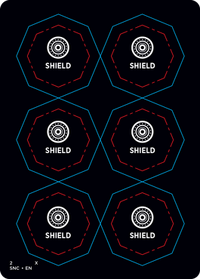Shield counter
| Shield counter | |
|---|---|
|
[[File:{{#setmainimage:Icon Shield-Counter.png}}|70x70px]] | |
| Counter | |
| Use | Prevent destruction and damage |
| Placed on | Permanents |
| Introduced | Streets of New Capenna |
| Last used | Modern Horizons 3 |
| Statistics | |
|
23 cards | |
| Scryfall search | |
| oracle:"Shield counter" | |
Shield counters were introduced in Streets of New Capenna as the signature Brokers mechanic.[1][2]
Description

Shield counters provide two benefits. First, if a permanent with a shield counter on it would be destroyed by an effect, a shield counter is removed from the permanent instead of it being destroyed.
The second benefit works against damage. If a permanent with a shield counter on it would be dealt damage, that damage is prevented and a shield counter is removed from the permanent.
This prevention effect works to stop any form of damage—combat damage, damage dealt by spells like Strangle, or damage dealt because of activated or triggered abilities.
History
Palliation Accord from Dissension was the first enchantment to use shield counters. After Shield counters were introduced as a mechanic in Streets of New Capenna, the shield counters on Palliation Accord were changed to palliation counters so there wouldn't be any confusion about them.[3]
Aspects of the problematic Regeneration mechanic are present with Shield counters. The use of a physical reminder bypasses the previous unmarked "regeneration shield" phrasing, and the removal of it serves as a more coherent replacement effect than the "instead it isn't" in regeneration text. While the typical creature usage of regeneration (activated ability) and shield counters (single as an entry effect) differ greatly in gameplay, Boon of Safety makes for a good approximation to Mending Touch, Scry 1 notwithstanding.
Rules
From the glossary of the Comprehensive Rules (June 7, 2024—Modern Horizons 3)
- Shield Counter
- A counter that protects a permanent from being damaged or destroyed. See rule 122.1c.
122.1c defines how shield counters work:
From the Comprehensive Rules (June 7, 2024—Modern Horizons 3)
- 122.1c One or more shield counters on a permanent create a single replacement effect and a single prevention effect that protect the permanent. These effects are “If this permanent would be destroyed as the result of an effect, instead remove a shield counter from it” and “If damage would be dealt to this permanent, prevent that damage and remove a shield counter from it.” See rule 614, “Replacement Effects,” and rule 615, “Prevention Effects.”
Rulings
- Shield counters won't work if the damage is unpreventable (e.g. Banefire). A shield counter will be removed and the creature or planeswalker will be dealt damage.
- Each instance of damage (and, for that matter, each destroy effect) removes only a single shield counter.
- Shield counters don't prevent players from sacrificing creatures.[4]
- Removing a shield counter in this way isn't the same as regenerating a creature.
- If a permanent that would be dealt damage has more than one shield counter on it, that damage is prevented and only one shield counter is removed.
- A creature with a shield counter on it may still be destroyed by state-based actions if it has damage marked on it equal to its toughness or has been dealt unpreventable damage by a source with deathtouch.
- "Shield" is not an ability that creatures have and shield counters are not keyword counters. If a creature with a shield counter loses its abilities, the shield counter will still protect it as normal.
Examples
Example
Disciplined Duelist ![]()
![]()
![]()
Creature — Human Citizen
2/1
Double strike
Disciplined Duelist enters the battlefield with a shield counter on it. (If it would be dealt damage or destroyed, remove a shield counter from it instead.)
References
- ↑ Matt Tabak (April 7, 2022). "Streets of New Capenna Mechanics". magicthegathering.com. Wizards of the Coast.
- ↑ Mark Rosewater (April 11, 2022). "Hitting the Streets of New Capenna, Part 2". magicthegathering.com. Wizards of the Coast.
- ↑ Mark Rosewater (April 9, 2022). "Will shield counters moved from Palliation Accord (Dissension) onto a creature interact with the Shield Counter mechanic in New Capenna?". Blogatog. Tumblr.
- ↑ Wizards of the Coast (April 20, 2022). "Streets of New Capenna Release Notes". magicthegathering.com. Wizards of the Coast.